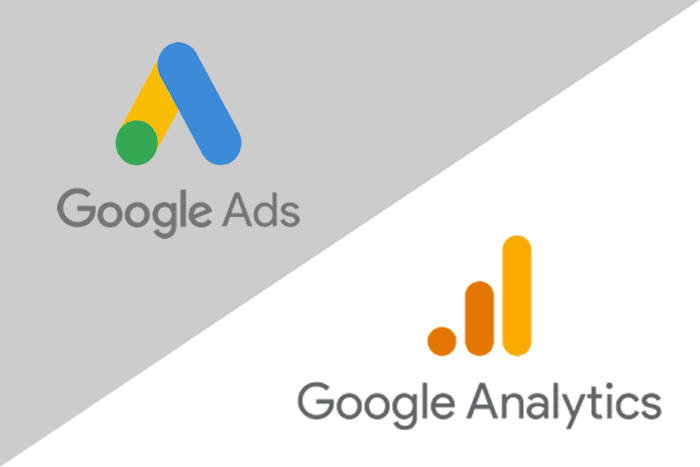Integrate Google ads and Google Analytics for the best insights into your paid campaigns
Google Ads and Analytics are essentials for any company using digital marketing as they really make a difference when it comes to results.
Both platforms have advanced features for all kinds of websites and provide valuable insights to help you improve your site performance. But have you ever wondered how much you can benefit from integrating your Google Ads and Analytics accounts?
Yes! You can (and should) use them together, and integrating them is much easier than you think. It’s also incredibly beneficial to your strategy.
In this article, we’ll cover how to integrate Google Ads and Google Analytics step by step. It only takes a few simple clicks! There’s also a list of 10 benefits you can gain from starting right away. Shall we get into it?
How to use Google Ads and Google Analytics together
Integrating your Google Analytics and Ads accounts lets you import data from ads on one end while sending info to help boost your campaign performance.
As a result, you can better understand the behavior of users attracted to your site through paid media. It also gives you necessary data to help you optimize audiences and conversion goals, and improves audience retention on your website.
But how do you integrate Google Analytics with Google Ads? It only takes a few simple steps. Before you get started, you’ll need to check your level of access on each platform.
Admin access is required for Google Ads, while Analytics requires permission to edit properties.
Once that’s done, follow the instructions below:
- Access your Google Ads account and click Tools and Settings in the top menu;
- In Settings, tap Linked Accounts;
- In from Google, select Google Analytics (UA) or GA4 and click Details;
- You’ll see a list of the properties you can access. Select the one linked to your Google Ads account;
- In Actions, tap Link to connect one or more site properties;
- You can now import site metrics and exchange data between accounts.
Once everything is in order, save your preferences. You’ll need to wait around a day for the channels to begin exchanging data.
10 advantages of integrating Google Ads and Analytics
After you’ve integrated your Google Ads and Google Analytics accounts, you can start reaping the benefits of analyzing and optimizing your campaigns. Here are 10:
1. Keep all your data in one place
You’ll notice the first benefit immediately after linking your Google Ads and Analytics. It will be much easier to thoroughly monitor your website performance in one place.
Analytics already captures hits from paid media automatically but integrating it with Google Ads gives you accurate reports on how your strategies impact your site.
That way, you can manage campaign goals and conversions easily and gain insights that lead to optimizing your audiences and website. That’s easy, isn’t it?
Find the Acquisition tab and select Google Ads to access your Analytics data. That opens a drop-down menu with a couple of options:
campaigns (general and by types, like Display and Shopping);
keywords and search analysis;
bid settings;
time of day and final URLs reporting;
site links data (new platform feature).
2. Keyword performance
Speaking of keywords, clicking on that option gives you access to a full report of terms that direct the most traffic to your site. You can also check your Cost Per Click performance, user behavior, and conversions.
Along with your purchased keywords data, you can check the Search Queries tab for the terms that boost your ads impressions.
That way, you can evaluate opportunities for purchasing keywords or ditch those not directly related to your ad, which helps with campaign optimization.
3. Bid Adjustments
This option in the drop-down menu lets you measure performance for bid adjustments you set for a campaign (devices, locations, and ad schedule).
From there, you can decide whether to increase or decrease your bid adjustments and improve your financial return on ads.
4. Time of day report
Do you know the best times and days to run ads on Google Ads? With the “Time of Day” report, you can access your site performance data and improve your targeting by time or period.
You can also track performance by device type to better understand user behavior.
5. Tracking final URLs
Another Google Ads report essential in Google Analytics is that you can evaluate final URLs set for ads.
This data opens the door to understanding user retention on pages and generating conversions, giving you precious insight into what improves your site so you can make it more attractive to visitors.
6. A more accurate analysis of paid traffic
Using Google Analytics to track campaign data more accurately gives you an integrated overview of data that directly impacts the success of your ads.
You’ll better understand how users get to your site, when, how long they remain on each page, and the devices they use to connect. It gives you a pretty good idea of what to optimize for more efficient strategies.
7. Importing goals
Integrating Google Ads and Google Analytics also optimizes the ad tool. One benefit is importing goals from the latter to the former.
Then, you can view Analytics conversion data in Google Ads and boost the effectiveness of your ads account.
Optimize your bids, for example, by giving Smart Bidding access to data. You’re more likely to drive conversions through campaigns and reduce your costs that way.
8. More efficient remarketing campaigns
But Smart Bidding isn’t the only way to optimize Google Ads. One of the most popular features of this integration is importing audience information from Analytics. That means remarketing your audiences with precision.
In other words, reaching users who have visited your website or app is easier, so you’ll likely have better results.
9. Automatic coding configuration
Integrating Google Ads and Analytics allows for automatic coding, adding a parameter to the URLs of ads, creating more complete reports, and monitoring conversions (even offline).
You’ll be able to track campaigns much more thoroughly through Google Analytics, without the hassle of having to add URL parameters manually, and can avoid mistakes when capturing ad performance data.
10. Get a better understanding of the impact of ads
The last benefit on this list goes to Google Analytics 4. The new version of Analytics has a tab you can click to analyze your advertising investments and how they impact the customer journey.
It makes for an in-depth analysis of:
- which channels get the most conversions;
- comparison between attribution models;
- Exact touchpoints where your customers convert;
- and insights to help you improve strategies and campaigns.
This makes sense when you consider that customer behavior is complex and the decision-making process is not always linear. So, there is a real need for careful analysis when it comes to integrating channels and understanding how they lead to conversion.
Did you like reading about the 10 benefits of Google Ads/Analytics integration?





